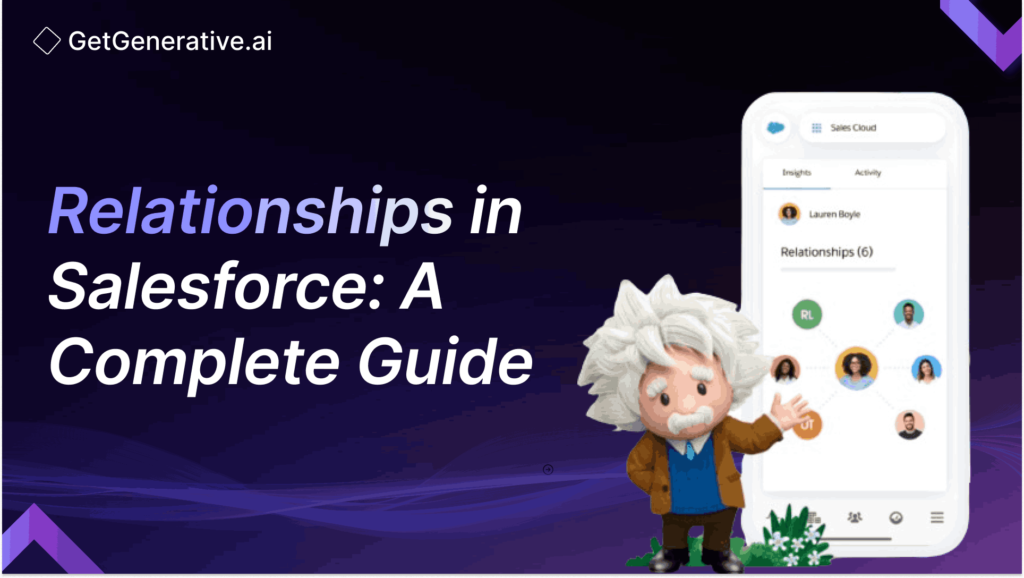Relationships in Salesforce: A Complete Guide 2025
Understanding and effectively implementing data relationships is the key to unlocking this potential in Salesforce.
What are Relationships in Salesforce?
Relationships in Salesforce are the connections between objects that allow you to link related data. These relationships are fundamental to effectively organizing and structuring your data within the Salesforce ecosystem. By establishing relationships, you can comprehensively view your business processes, customers, and operations.
Types of Relationships
Salesforce offers several types of relationships to cater to various business needs. Let’s explore each of them:
1. Lookup Relationships
Lookup relationships are the most basic type of relationship in Salesforce. They create a link between two objects, allowing you to “look up” related information from one object to another. For example, you might have a lookup relationship between a Contact object and an Account object, allowing you to associate contacts with their respective companies.
2. Master-Detail Relationship
Master-detail relationships create a tight coupling between two objects, where one object (the detail) is dependent on another (the master). This relationship type enforces data integrity and allows for features like roll-up summary fields. For instance, you might use a master-detail relationship between Opportunities (detail) and Accounts (master) to roll up the total value of all opportunities for an account.
3. Many-to-Many Relationships
Many-to-many relationships allow you to connect records from one object to multiple records in another and vice versa. This is typically achieved using a junction object. For example, you might have a many-to-many relationship between Products and Opportunities, where a single product can be associated with multiple opportunities, and an opportunity can include various products.
4. Self Relationship
A self-relationship, also known as a recursive relationship, allows records within the same object to be related. This is useful for hierarchical data structures. For example, you might use a self-relationship on the Contact object to represent reporting structures within a company.
5. External Relationships
External relationships allow you to connect Salesforce objects with external data sources. This is particularly useful when integrating Salesforce with other systems or databases. External relationships use external IDs to maintain the connection between Salesforce and the external system.
6. Hierarchical Relationships
Hierarchical relationships are a special self-relationship used specifically on the User object. They allow you to create management hierarchies within your Salesforce org, which can be useful for approval processes and reporting structures.
What are the Best Practices for Using Lookup Relationships?
When working with lookup relationships in Salesforce, consider the following best practices:
- Use lookup filters to restrict users’ values in lookup fields, ensuring data accuracy and relevance.
- Implement field-level security to control which users can see or edit lookup fields.
- Create custom list views to help users quickly find the right records when populating lookup fields.
- Use junction objects for many-to-many relationships instead of multiple lookup fields.
- Regularly review and clean up orphaned records that may result from deleted lookup relationships.
Also Read – Salesforce Einstein: Exploring 10 Key AI Features in Depth
What are the Advantages of Using Roll-up Summary Fields in Salesforce?
Roll-up summary fields, available in master-detail relationships, offer several advantages:
- Automatic calculations: Roll-up summary fields automatically aggregate data from related detail records, saving time and reducing errors.
- Real-time updates: As detail records are modified, roll-up summary fields update in real-time, providing up-to-date information.
- Improved reporting: By consolidating data at the master record level, roll-up summary fields simplify reporting and data analysis.
- Trigger efficiency: Using roll-up summary fields can reduce the need for complex triggers, improving system performance.
- Enhanced visibility: They provide a quick overview of related data without navigating to detailed records.
Real-World Use Cases for Relationships in Salesforce
1. Lookup Relationship: Connecting Contacts to Accounts
- Scenario: A company wants to track its customers (Contacts) and the businesses they are associated with (Accounts).
- Solution: Use a lookup relationship between the Contact and Account objects. This ensures that each contact is linked to their respective company, enabling detailed account-level reporting and segmentation.
2. Master-Detail Relationship: Tracking Campaign ROI
- Scenario: A marketing team wants to measure the return on investment (ROI) for their campaigns.
- Solution: Create a master-detail relationship between Campaign (master) and Campaign Member (detail). Use roll-up summary fields to calculate the total revenue generated by each campaign.
3. Many-to-Many Relationship: Managing Product Bundles
- Scenario: A company sells product bundles consisting of multiple items, and these bundles are included in various sales opportunities.
- Solution: Use a junction object, such as Product Bundle, to link Products and Opportunities. This allows for seamless management of many-to-many relationships between products and sales opportunities.
4. Self-Relationship: Representing Organizational Hierarchies
- Scenario: A global company wants to represent the reporting structure of its employees.
- Solution: Use a self-relationship on the User object to connect managers and subordinates. This hierarchical relationship can be leveraged for approval workflows and reporting.
5. External Relationships: Integrating with an ERP System
- Scenario: A business needs to link Salesforce data with an external ERP system to synchronize inventory details.
- Solution: Use external objects with external relationships to connect Salesforce to the ERP database, enabling real-time access to inventory data within Salesforce.
Conclusion
Understanding and effectively utilizing relationships in Salesforce is crucial for building a robust and efficient CRM system. By leveraging various relationships and following best practices, you can create a data model that accurately represents your business processes and supports your organizational needs. Remember that the key to success is carefully planning and regularly maintaining your Salesforce relationships.
Enhance your Salesforce consulting with GetGenerative.ai. Effortlessly craft outstanding proposals, enabling you to dedicate more time to providing exceptional client service.
Start today!
Frequently Asked Questions (FAQs)
1. Can I change a lookup relationship to a master-detail relationship?
Yes, you can convert a lookup relationship to a master-detail relationship, but certain conditions must be met, such as populating all the lookup fields.
2. How many lookup relationships can an object have?
Standard objects can have up to 40 lookup relationships, while custom objects can have up to 25.
3. Can I use roll-up summary fields with lookup relationships?
No, roll-up summary fields are only available with master-detail relationships. To achieve similar functionality for lookup relationships, you would need to use Apex triggers or third-party tools.
4. What happens to child records when a master record is deleted in a master-detail relationship?
By default, all child records are automatically deleted when the master record is deleted. This behavior can be customized to transfer child records to another master record before deletion.
5. Can I create relationships between objects in different Salesforce orgs?
Direct relationships between objects in different orgs are not possible. However, external objects and relationships can connect data across various systems or orgs.




